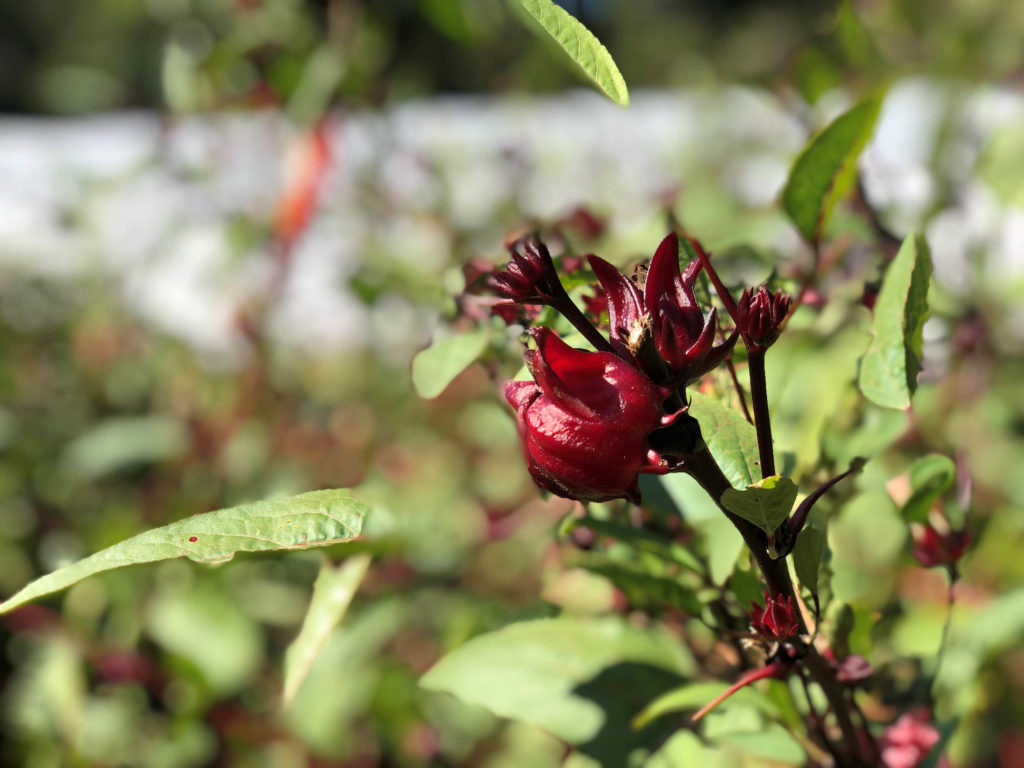By Clint Thompson
Sorrel is a potential new crop for Florida specialty crop producers. It is easy to grow and requires minimal inputs but can suffer in fields prone to flooding.

While more research is needed to verify sorrel’s place among growers, it has yielded promising early returns in University of Florida Institute of Food and Agricultural Sciences (UF/IFAS) research, says Norma Samuel, UF/IFAS Extension horticulture agent.
“You can sell the calyces dry, or you can sell them fresh. I’ve seen the calyces in an ethnic food store for $6 or $7 a pound. You have potential to make significant amounts of money on it as a cash crop,” Samuel says. “It’s easy to grow with very little inputs. From our experience so far, you need to make sure you don’t put it in an area that’s going to get a lot of water.”
Samuel, along with UF/IFAS colleagues Matt Smith, sustainable agriculture and food systems agent, and Brandon White, Extension agent in commercial crop production, are studying four sorrel varieties. The two-year project has already yielded important data related to rainfall. During the summer of 2021, the crop struggled in fields in low-lying areas amid a season of persistent rains.
“You need to make sure that the area you’re planting is one that usually doesn’t get flooded in the summer. You want to make sure it’s not in a low-lying area or else you’ll come down with fusarium, phytophthora and southern blight,” Samuel warns.
EDIBLE OPTIONS
Sorrel is a leafy green plant with reddish-pink flowers. Samuel says it is a relative of okra, cotton and hibiscus and performs well in Florida’s climate. One of its key benefits is that it can be sold and used in various ways.
Samuel, who was raised in the Caribbean, says sorrel is grown widely there for its calyces. “After the petals fall off, the red potion that remains is what we use to make drinks,” she explains. “However, in countries like Africa and also here in the United States, people have been developing niche markets for it where they use the leaves as greens. You can use it in salads.”
The calyces can be used for jams, ice cream, apple sorrel pie and wines.
“It’s pretty endless in terms of the possibilities of foods you can create with it,” Samuel says.
WORK UNDERWAY
UF/IFAS Extension agents, in collaboration with the University of the Virgin Islands and central Florida farmers, are growing research plots of the crop to understand its potential for commercial growth in Florida. The work is funded by a U.S. Department of Agriculture Sustainable Agriculture Research and Education grant titled “Evaluating sorrel (Hibiscus sabdariffa) varieties for production in Florida.”
“Once the season is done this year, we will develop fact sheets that farmers can use,” Samuel says. “We’re hoping that the data we get from this small grant will help catapult us to bigger opportunities where we can do further research with the crop.”
She would like to see more marketing of the crop, not only to farmers, but also to residents of Florida and throughout the South so that they can see sorrel’s wide uses. “Hopefully, we can do research on nutritional content and all those sorts of things, not only on the crop but the products that can be developed from it,” Samuel adds.
She reports the success one grower has already seen with sorrel: “One of the farmers was very happy because it’s hard to grow greens in Florida in the summer,” Samuel says. “She was thankful for sorrel because you can just snip the leaves off, bundle them, put them in bags and take them to the market. That was how she was making money on greens from harvesting the leaves.”









